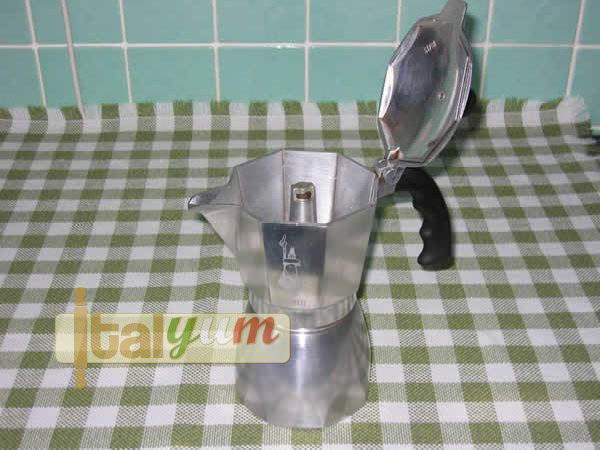Preparing coffee with the moka applies to the “tiramisù” recipe, featured in the dessert section of the website

Here, I have gathered some information with the aim of giving a rough guide to those interested in Italian coffee and how to prepare it.
Coffee is considered, by most, the perfect accompaniment to end our meals and Italians love it so much that they constantly pursue the perfect coffee through the creation of new blends and ways of preparing it. There are different ways of preparing the coffee but here I would like to focus only on the most traditional, as made by most Italian families at home, using a traditional stove top coffee maker (a.k.a. moka).
When speaking about moka, everybody in Italy associates it with its most famous manufacturer “Bialetti”. The moka is a coffee pot patented in 1933 by the Italian company Bialetti. It is made of three parts: the lower pot (the one with the safety valve), the filter cup (the one with lots of tiny holes that looks like a funnel) and the top pot (the one with a chimney in the middle). The Bialetti traditional moka is made of aluminium and this is still my favourite despite the market, nowadays, producing endless variation of it, with new designs and materials (e.g. made of stainless steel).
To make a good coffee you need to follow a few simple rules:
Blending & grinding
The blend is important and in Italy there are many companies called “torrefazione artigianale” that specialise in blending and roasting the coffee beans. Each of these companies has their own secrets and their job is taken so seriously that I would compare it to the one carried out by a Scottish distillery when preapring their own blended whisky.
There are about 60 coffee plant varieties in the world but only a dozen are used commercially to create these blends. Choosing a blend is very much a matter of choice and personal taste. My suggestion is to try different blends from different producers. Once you find the right one for you, you are likely to stick to it forever! If you are in Italy and have the chance to go to Naples or Trieste, try to taste their “caffe` espresso” at the bar; apparently is the best you can taste in the country.
When buying your blend, check that it is not too old and make sure it is not one specifically made for espresso machines. The coffee for espresso machines is grinded too finely and, if you use it with a moka, the result will be a slightly bitter coffee. So, check that the pack says ” for moka use” or “suitable for all coffee makers”.
All the coffee containers/packs you find at the supermarket should be vacuum packed. This avoids the coffee absorbing any other odour that would compromise its original aroma. Once the container is open, you should put the coffee in a tin or glass jar with an airthight lid and keep the jar in a fresh, dark place. For extended storage, some people keep their coffee in the bottom of the fridge. I would not suggest buying whole coffee beans, unless you know exactly how to grind them and how to identify if the beans have been roasted correctly.
Water
This is extremely important! To make a good coffee you need to use soft and possibly unchlorinated water. In Naples, they say that the secret for a good coffee is in the water (this is also the secret for making a good pizza dough).
Using the coffee pot
Firstly, fill the lower pot with cold water. The water level should stay below the safety valve (usually there is a notch inside the lower pot that shows the correct water level). However, I strongly recommend checking on the manufacturer’s instruction leaflet how much water to put in the lower pot (this is a safety issue as well!).
Next, set the filter cup inside the lower pot and put the coffee in the filter cup. The coffee should be levelled with the cup edge (or slighlty below) and never press the coffe down, just let it fall gently from your spoon into the filter cup. Now, close the whole moka by tightening the top pot with the lower pot and then put the moka on a low heat. After a few minutes you will see the main coffee flow coming from the top of the chimney. When the main flow is near to the end, it will start spurting, so remove the moka from the heat. Purists say that the last part of the “spurting flow” is just steam and water and that would spoil the coffee. Before serving the coffee, stir it when it is still in the moka, so it is evenly distributed (the first coffee coming out is different from the last).
Just a warning: never leave the coffee to boil, this would burn the coffee.
When using a brand new moka for the first time, you should use it only with water and then discard the water. The second time, make your coffee as per instructions and discard it. Having done that, the moka is ready and you can have your coffee. The older the moka the better your coffee!
Cleaning the moka
Never use washing up liquid or other detergents. Rinse all the components with fresh running water and to remove traces of coffee you may use a small brush (a tooth brush is ideal for this purpose). Also, refer to the moka manufacturer’s instructions leaflet concerning the cleaning of the moka and its safety valve.
The coffee cup
Purists drink their coffee in pre-heated porcelain cups. If you want to buy these kind of cups, be sure that the wall of the cup is thick.
About the espresso machines
These machines make a coffee in about 20 seconds; hot water passes through the filter at a higher pressure than a traditional moka, which gives the name “espesso” (fast). Espresso machines are great and the coffee is usually better than the coffee prepared with the moka; I would say more intense. However, the coffee is good only if the machine is used every day and many times like in every Italian bar, restaurant or motorway station (Autogrill). Unless you run a coffee shop or you have 100 guests per day in your house, I do not see the point of having one of these machines; they need more maintenance as well so it is probbaly better to leave these machines to the coffee shops.
